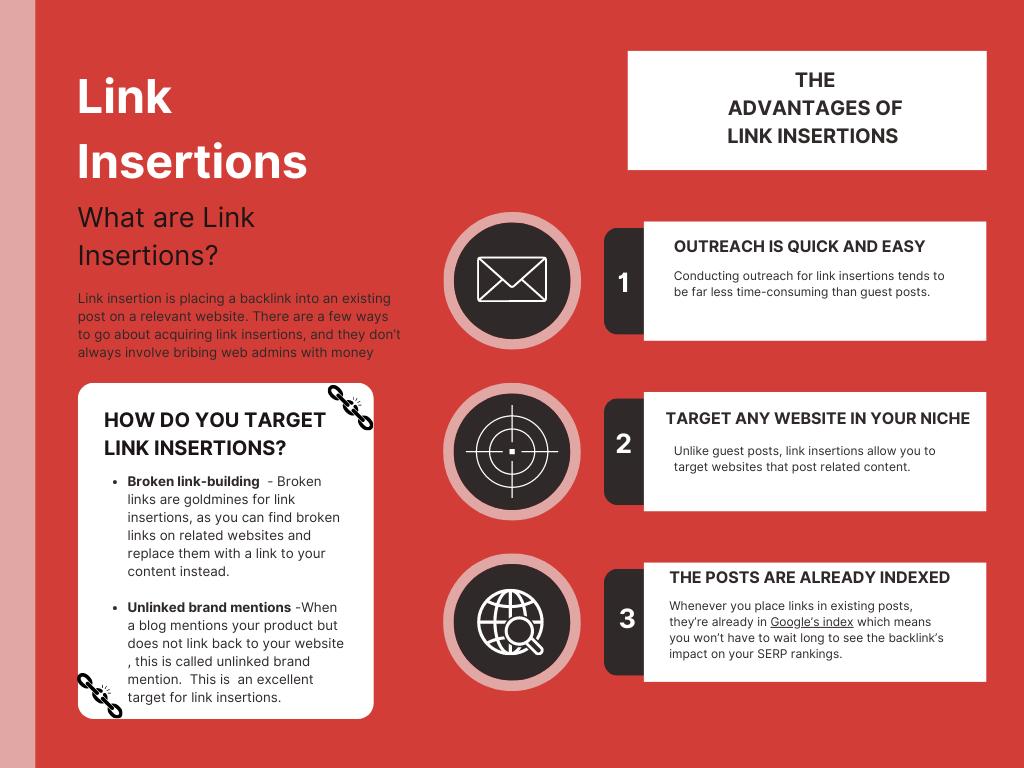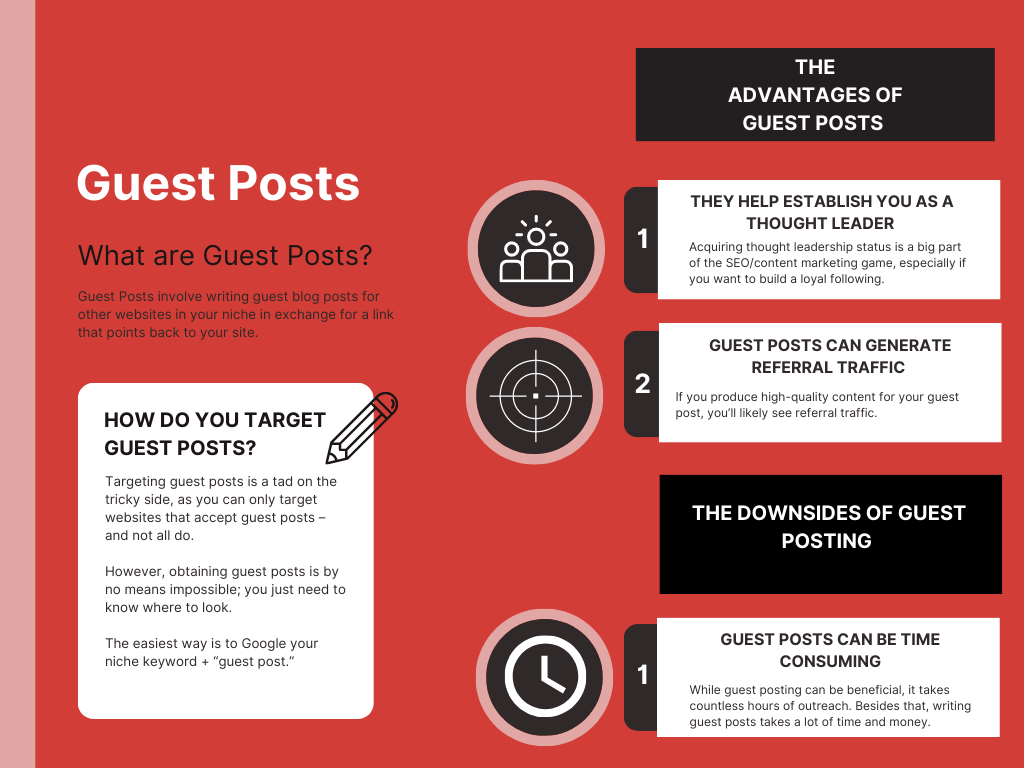Quick Links
If you’re conducting an SEO campaign on Google, you’ll definitely want to allocate plenty of time and resources toward building a healthy link profile.
Backlinks are an essential ranking factor for Google’s search algorithms, as they value websites that get lots of links from trusted, authoritative websites.
Out of all the ways to obtain backlinks, there’s a lot of debate surrounding link insertions vs. guest posts.
Both are methods that can land you backlinks, but which works better?
In particular, which method will generate the most authoritative backlinks for you at the lowest cost in terms of time and money?
These are the questions that we’re here to answer today.
Link-building is one of the most effective SEO tactics, as 67.5% of digital marketing experts agree that backlinks have a significant impact on SERP (search engine results pages) rankings.
However, it’s also one of the most challenging and time-consuming aspects of SEO.
In fact, 65% of marketers feel that link-building is the most difficult & challenging part of optimizing a site for search engines.
Since link-building is so effective yet challenging, finding the best technique to build backlinks is crucial – which is where link insertions and guest posts come into play.
Should you target existing posts to insert your backlinks, or is opting to create guest blogs the better option?
Both methods have unique advantages and disadvantages, so stay tuned as we compare and contrast link insertions vs. guest posts.
What are Link Insertions?
Let’s start by defining link insertions, which you’ll see go by several different names online.
Link insertions are also called contextual links, link placements, and niche edits.
So what are they?
Regardless of the name, they all refer to the same thing – placing a backlink into an existing post on a relevant website.
For instance, if you’re in the fitness niche, you could target other fitness blogs and websites for link placements.
Scroll through their blog archive until you find a post that aligns with one of your target pages (i.e., the pages you want to acquire backlinks for). It could be that the post mentions a similar topic or one of your products could be a perfect fit for the content.
To try and snag a link placement, you would then reach out to the webmaster to ask if you can place a link on the page you found.
To sweeten the pot, you can offer a few ways to update the post and make it fresh again, such as adding new insights.
That’ll increase your chances of securing the link insertion since it’ll be beneficial to the webmaster to update an aging piece of content – making it relevant & rankable again.
Another way to convince webmasters to add your links is to offer money or another type of reward in exchange for the placement.
However, this is technically against Google’s Webmaster Guidelines, hence why offering money for link placements is considered a ‘gray hat’ technique.
How Do You Target Link Insertions?
There are a few ways to go about acquiring link insertions, and they don’t always involve bribing web admins with money – which is good news.
The ‘white hat’ way to acquire link insertions is to offer value to the webmaster – either by updating their content or offering something else of value, like a guest post spot on your blog in return.
These methods are far less likely to land you in hot water with Google, which is why they’re considered ‘white hat’ (the good guy way).
However, targeting these types of link insertions tends to be the most time-consuming, which is why some site owners choose the gray hat route instead.
Two other methods for targeting link insertions are finding broken links and unlinked brand mentions online.
Broken link-building
Link rot is a very real phenomenon that affects every website in existence, regardless of industry.
It’s where links no longer point to their original destination, either because they’ve been relocated to a new address or aren’t available anymore.
According to a link rot study by Ahrefs, approximately 66.5% of links placed in the last 9 years are now dead.
The good news?
Broken links are goldmines for link insertions, as you can find broken links on related websites and replace them with a link to your content instead.
This is another mutually beneficial technique, as the webmaster gets to get rid of a broken link (which is notoriously bad for SEO), and you get a link insertion.
Ahrefs has a broken link checker tool that you can use to uncover dead links on websites in your niche.
You’ll want to find websites that have excellent metrics; otherwise, acquiring a backlink from them won’t do you any good.
You can use our free backlink checker tool from The HOTH to gauge the quality of each domain. If the website has a strong domain authority score, it’s worth pursuing a link insertion.
However, websites that have poor link profiles aren’t worth your time, so don’t target a link insertion until you find the right site to target.
Unlinked brand mentions
Even if your site isn’t a household name, there are likely instances where other websites mention your brand online but fail to link to you.
It could be that a blog mentioned your business or a website may have reviewed one of your products.
They mention your brand, which is great, but they didn’t link back to your website.
These are known as unlinked brand mentions, and they’re excellent targets for link insertions.
After all, the website already mentioned your business, so why not take the extra step and add a link back to your site?
What’s great about these unlinked mentions is that you get to choose which page you want the link to point at, so it doesn’t have to be your homepage only.
Ideally, you should try to build an adequate number of links for each page that you want to dominate the SERP rankings. So if you can find an unlinked brand mention, you should link to your pages that are in desperate need of link juice.
To find them, you can use advanced search modifiers on Google.
By searching for ‘site:yourdomain.com,’ you can find instances where other websites mentioned you.
There are other modifiers you can use, too, like the exact match modifier “query” or the similar query modifier ‘Query OR query.’
Besides searching for your brand name, you can also try searching for prominent employees, your products, and company phrases/slogans.
The Advantages of Link Insertions
Now that you know more about link insertions and how to target them, why should you bother? What are the upsides of using link placements over other link-building techniques?
Here’s a breakdown of all the benefits of using link insertions.
Outreach is quick and easy
Conducting outreach for link insertions tends to be far less time-consuming than guest posts.
Instead of pitching a brand-new piece of content, you’re simply asking to place a link in an existing piece.
Since outreach is so simple, you’ll be able to reach out to twice as many websites as you would with guest posts.
You can target any website in your niche
Guest posts are limited in that you can only write for websites that accept guest posts.
You don’t have that problem with link insertions, so any website that posts related content is fair game.
The posts are already indexed
This benefit is a really significant one. Whenever you place links in existing posts, they’re already in Google’s index.
That means you won’t have to wait long to see the backlink’s impact on your SERP rankings.
Whenever you create a brand-new guest post, you have to wait for Google to index it – which can take weeks or even months.
The Drawbacks of Link Insertions
It’s not all peaches and roses with link insertions, as there are some noticeable downsides.
For one, even white hat techniques can land you in hot water with Google at times, as, technically, any form of link-building violates their guidelines.
Another drawback is it can be difficult to convince web admins to add links to their existing pieces, especially if you don’t have any ways to add further value to the post.
What are Guest Posts?
Guest posting is a tried-and-true link-building tactic that’s been around for a while.
It involves writing guest blog posts for other websites in your niche in exchange for a link that points back to your site.
In addition to acquiring a backlink, guest posts also expose your content and brand to a new audience, which is a bonus.
For a guest post to count toward your link profile, it needs to take place on a relevant website that directly relates to your content.
That means you won’t be able to target just any website for a guest post, only related blogs in your industry.
If the guest posts you create truly add value to your target audience, they’ll help you build authority, generate more traffic, and convert users into customers.
It’s common for two blogs to trade guest posts; that way, each website benefits from a backlink and exposure to a new audience.
How long should a guest post be to see the best results?
In general, your guest posts should always be long-form and contain at least 2,000 – 3,000 words.
Research has shown that users are more likely to share long-form content over shorter posts, as they tend to be more informative and educational.
How Do You Target Guest Posts?
Targeting guest posts is a tad on the tricky side, as you can only target websites that accept guest posts – and not all do.
That’s why link insertions are easier to target than guest posts, as you aren’t limited to sites that accept outside posts.
However, obtaining guest posts is by no means impossible; you just need to know where to look.
Once again, advanced search operators on Google are here to save the day.
The easiest way to use them is to copy this format: your niche keyword “guest post.”
Here’s an example for the fitness industry: fitness “guest post.”
Since ‘guest post’ is in quotations, Google will display exact matches for it, and you’ll get to see a list of fitness websites that accept guest posts.
The Advantages of Guest Posts
Why should you target guest posts instead of link insertions?
Well, there are a few benefits you’ll enjoy that you won’t if you only use link insertions.
Here’s a look at the top perks of using guest posts to acquire backlinks.
They help establish you as a thought leader
Acquiring thought leadership status is a big part of the SEO/content marketing game, especially if you want to build a loyal following.
An edge guest posts have over link insertions is the content you create will build your authority and reputation with your target audience.
Guest posts can generate referral traffic
If you produce high-quality content for your guest post, you’ll likely see referral traffic. That’s where avid readers of the other blog discover your website and start reading your blogs.
That doesn’t really happen with older articles that only receive one of your links and not much else.
The Downsides of Guest Posting
While guest posting can be beneficial, it takes countless hours of outreach.
In fact, you may go back and forth with several web admins and not even land a single guest spot.
Besides that, writing guest posts takes a lot of time and money.
That’s especially true when you consider that most guest posts need to be long-form, requiring even more effort than a standard blog post.
Lastly, it takes a long time for new guest posts to appear in Google’s index. That means you’ll have to wait quite a while to see the impact of the backlink on your link profile.
The Final Verdict: Link Insertions vs. Guest Posts
By now, you’ve seen the advantages and disadvantages of both link insertions and guest posts.
Which link-building technique won the battle?
For us, the best option is always to use a combination of link-building techniques, and there’s no rule that says you can’t use link insertions and guest posting in tandem.
Do you need help developing a successful link-building strategy for your business?
Then don’t wait to check out our insanely effective link outreach services from The HOTH. Our link-building gurus will generate real results for your business, so don’t wait to get in touch now.











Thank You for the detailed post. I love implementing both strategies and they work very well when combined together.
very informative
Thank You for this